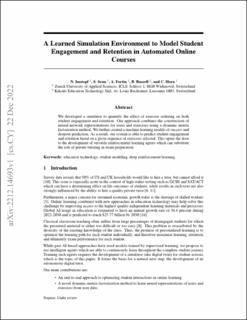Please use this identifier to cite or link to this item:
https://doi.org/10.21256/zhaw-26814Full metadata record
| DC Field | Value | Language |
|---|---|---|
| dc.contributor.author | Imstepf, Nicolas | - |
| dc.contributor.author | Senn, Saskia | - |
| dc.contributor.author | Fortin, Antonio | - |
| dc.contributor.author | Russell, Benjamin | - |
| dc.contributor.author | Horn, Claus | - |
| dc.date.accessioned | 2023-02-09T09:18:13Z | - |
| dc.date.available | 2023-02-09T09:18:13Z | - |
| dc.date.issued | 2022-12-22 | - |
| dc.identifier.other | arXiv:2212.14693 | de_CH |
| dc.identifier.uri | https://digitalcollection.zhaw.ch/handle/11475/26814 | - |
| dc.description.abstract | We developed a simulator to quantify the effect of exercise ordering on both student engagement and retention. Our approach combines the construction of neural network representations for users and exercises using a dynamic matrix factorization method. We further created machine learning models of success and dropout prediction. As a result, our system is able to predict student engagement and retention based on a given sequence of exercises selected. This opens the door to the development of versatile reinforcement learning agents which can substitute the role of private tutoring in exam preparation. | de_CH |
| dc.format.extent | 6 | de_CH |
| dc.language.iso | en | de_CH |
| dc.publisher | arXiv | de_CH |
| dc.rights | https://creativecommons.org/licenses/by-nc-nd/4.0/ | de_CH |
| dc.subject | Education technology | de_CH |
| dc.subject | Student modeling | de_CH |
| dc.subject | Deep reinforcement learning | de_CH |
| dc.subject.ddc | 378: Hochschulbildung | de_CH |
| dc.title | A learned simulation environment to model student engagement and retention in automated online courses | de_CH |
| dc.type | Working Paper – Gutachten – Studie | de_CH |
| dcterms.type | Text | de_CH |
| zhaw.departement | Life Sciences und Facility Management | de_CH |
| zhaw.organisationalunit | Institut für Chemie und Biotechnologie (ICBT) | de_CH |
| zhaw.organisationalunit | Institut für Computational Life Sciences (ICLS) | de_CH |
| dc.identifier.doi | 10.48550/arXiv.2212.14693 | de_CH |
| dc.identifier.doi | 10.21256/zhaw-26814 | - |
| zhaw.funding.eu | No | de_CH |
| zhaw.originated.zhaw | Yes | de_CH |
| zhaw.webfeed | Autonomous Systems and Reinforcement Learning | de_CH |
| zhaw.webfeed | Biokatalyse | de_CH |
| zhaw.funding.zhaw | Optimierung von Online-Bildungssystemen mit Hilfe von Reinforcement Learning | de_CH |
| zhaw.author.additional | No | de_CH |
| zhaw.display.portrait | Yes | de_CH |
| Appears in collections: | Publikationen Life Sciences und Facility Management | |
Files in This Item:
| File | Description | Size | Format | |
|---|---|---|---|---|
| 2022_Imstepf-etal_Learned-simulation.environment-student-engagement-retention.pdf | 738 kB | Adobe PDF |  View/Open |
Show simple item record
Imstepf, N., Senn, S., Fortin, A., Russell, B., & Horn, C. (2022). A learned simulation environment to model student engagement and retention in automated online courses. arXiv. https://doi.org/10.48550/arXiv.2212.14693
Imstepf, N. et al. (2022) A learned simulation environment to model student engagement and retention in automated online courses. arXiv. Available at: https://doi.org/10.48550/arXiv.2212.14693.
N. Imstepf, S. Senn, A. Fortin, B. Russell, and C. Horn, “A learned simulation environment to model student engagement and retention in automated online courses,” arXiv, Dec. 2022. doi: 10.48550/arXiv.2212.14693.
IMSTEPF, Nicolas, Saskia SENN, Antonio FORTIN, Benjamin RUSSELL und Claus HORN, 2022. A learned simulation environment to model student engagement and retention in automated online courses. arXiv
Imstepf, Nicolas, Saskia Senn, Antonio Fortin, Benjamin Russell, and Claus Horn. 2022. “A Learned Simulation Environment to Model Student Engagement and Retention in Automated Online Courses.” arXiv. https://doi.org/10.48550/arXiv.2212.14693.
Imstepf, Nicolas, et al. A Learned Simulation Environment to Model Student Engagement and Retention in Automated Online Courses. arXiv, 22 Dec. 2022, https://doi.org/10.48550/arXiv.2212.14693.
Items in DSpace are protected by copyright, with all rights reserved, unless otherwise indicated.